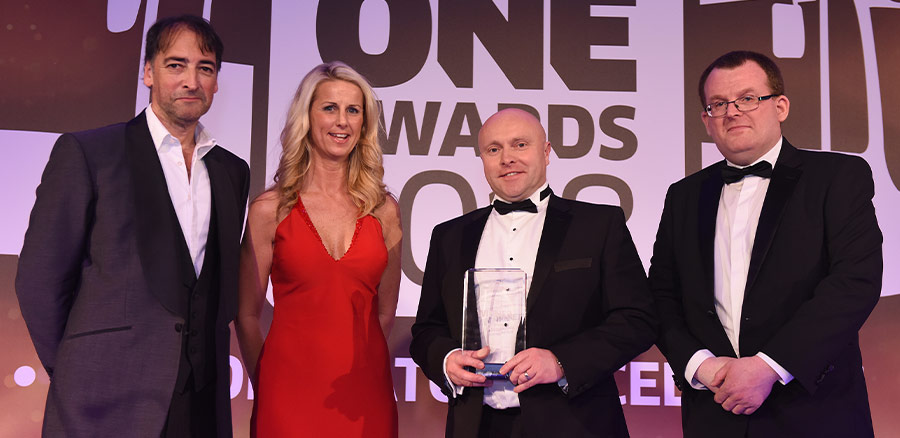National Express Rides Video Telematics Success to Top Safety Honors

National Express Operations and Safety Director Mark Heffernan (second from right) with the routeone award for Best Use of Technology.
Global transport company National Express operates the UK’s largest scheduled coach operation, covering 72 million miles a year and serving more than 750 towns, cities and airports. It also operates local bus services across the West Midlands, Coventry and Dundee.
With millions of individuals traveling on National Express buses and coaches every year, safety is paramount for the transport operator. So it’s no small achievement that National Express is making headlines in the UK for its efforts to use transport technology to improve safety.
The company’s hard work has paid off in the form of two national awards. The National Express UK bus and coach divisions recently took top honors at the routeone Awards for Best Use of Technology. The bus division also earned ROSCO’s Gold Award for Innovation in Road Safety at the UK Bus Awards, a nod toward its innovative use of the Lytx Driver Safety Program.
Technology awards highlight national express’ safety innovation
Together, the awards highlight the innovative ways National Express has used video telematics to reduce collisions and risky behaviors on its buses and coaches, and how the company is helping to create safer roads in the United Kingdom.
It’s no coincidence that National Express earned accolades for safety performance. After all, the company has steadfastly worked to enhance safety for years. National Express Operations and Safety Director Mark Heffernan is open about the way video telematics has helped elevate the company’s safety performance.
“Safety is our number one priority,” he said. “We’re constantly exploring new technologies that can reduce harm and improve the safety of our drivers, passengers and those sharing the road with them. With the help of the Lytx Driver Safety Program, we’ve seen how technology can help to protect our people, passengers and vehicles while keeping our collision costs down.”
Cultivating driver improvement through positive reinforcement
What lies at the heart of all these safety improvements? Driver coaching.
To complement the rollout of the Lytx Driver Safety Program, National Express’s Learning and Development team implemented “Manager as Coach”, a professional coaching course to assist in the effective coaching of recorded events. Most notably, it has led to increased engagement between drivers and managers. By improving driver behaviors and skills, coaching also has led to other benefits for National Express, such as improved fuel efficiency, reduced insurance premiums and greater revelation of spurious claims, thereby reducing pay out and repair costs.
“Ongoing coaching is vital and is used in all sessions with our drivers,” Heffernan said. “As a result, we’ve been able to greatly improve driver behavior, and by extension, our overall safety record and reputation. As part of the driver coaching program, we use open questioning to help drivers identify their own errors and work together to find a solution going forward.”
The marked safety improvements National Express made year-over-year from 2017 to 2018 earned the attention of judges at the UK routeone Awards and the UK Bus Awards. Among the improvements the UK coach division achieved: a 48 percent reduction in collisions; a 44 percent decrease in incident severity; and a 50 percent reduction in drivers’ late responses, such as late braking or steering.
The National Express UK bus division, meanwhile, saw a 23 percent dip in collisions, a 21 percent decline in near-misses and a 31 percent reduction in late responses. Propelling these improvements was an effort at National Express to boost driver engagement in the form of coaching.
“Through ongoing coaching as part of regular and timely communication with our drivers after recorded events, we’ve been able to greatly improve learnings and engagement between our drivers and managers,” Heffernan said.
National Express began considering video telematics as a safety solution in 2014. It was exploring technologies to help reduce collisions and near-collisions, along with ways to increase safe driving habits and skill among its drivers. After a successful trial that saw a 26 percent reduction in the frequency of unsafe events, a 35 percent improvement in event severity and a 53 percent decline in near-collisions, National Express chose to invest in the Lytx Driver Safety Program, rolling it out across its entire UK fleet of 760 coaches and 1,800 buses.
Ahead of the trial, National Express also ramped up its efforts to engage staff from other areas of the business to ensure the project’s success. The company formed a communications and training plan, engaging the Service Delivery, Human Resources, Learning and Development and Communications teams to ensure that all drivers and managers were fully engaged and informed throughout the project.
“Overall, video telematics has helped to elevate the level of safety in our drivers and our fleet,” Heffernan said. “By harnessing the power of video, we’ve been able to investigate incidents, coach our drivers, and improve UK road safety for our drivers, our passengers and those sharing the road with them.”
